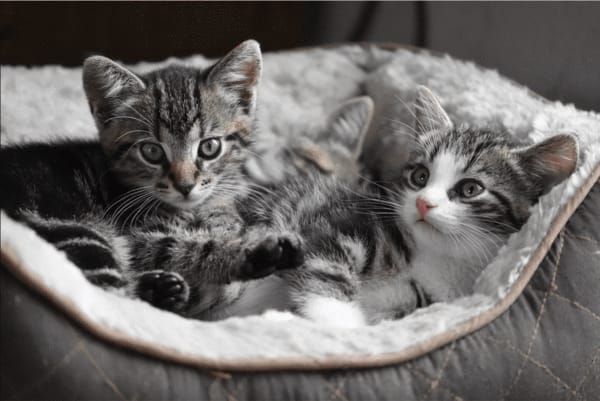August 3, 2025 |7 min read
Why Does My Cat Attack Me? Understanding Your Feline Friend

Written by

Cats have a way of keeping us on our toes. One moment they’re curled up purring on our laps, and the next they might swat at our hand or scratch us. If you’ve ever found yourself wondering, “Why does my cat attack me?” it often comes down to the complexities of feline behavior, where what feels like aggression usually has a deeper cause.
2 Common Reasons Cats May Attack Their Owners
Cats are creatures of habit, mystery, and surprise. When your cat suddenly lashes out, it’s rarely “for no reason,” but this is not a cause for fear. Here are two of the most common triggers behind those unexpected claws or bites:
-
Overstimulation During Petting or Play
Cats love affection, but they also have boundaries. Picture this: You’re scratching behind your cat’s ears, petting their back, they’re purring, and their eyes are half-closed. And then, in a heartbeat, they nip at your hand. So, what happened? Chances are, your cat reached their limit.
Overstimulation is a very real thing, and once your cat has had enough, they’ll let you know in the only way they can. Gentle cat biting, swats, or suddenly darting away are all feline shorthand for “that’s enough, thank you!”
-
Redirected Aggression
Sometimes, your kitten isn’t really upset with you; you’re just in the wrong place at the wrong time. Redirected aggression happens when your cat is wound up by something else (like seeing another cat outside the window or hearing a loud noise), and since they can’t act on that frustration directly, they redirect it toward you. It may feel personal, but it’s not. It’s their instinctual way of unloading pent-up tension.
Understanding these patterns helps you start to answer the question—Why does my cat attack me for no reason? Spoiler alert: It’s almost never without reason. The key is learning how to read the signs before your cat reaches their breaking point.
Cat Litter That Prioritizes Their
Health & Your Happiness.
to get your first bag for only $14.99
How to Tell If It’s Playful or Aggressive Behavior
Not all “attacks” are rooted in true aggression. Sometimes, your cat is just playing rough. The challenge lies in telling the difference between a playful pounce and a serious strike.
Signs of Play vs. True Aggression
When your cat is playing, you’ll often notice loose, wiggly body movements, ears perked forward, and claws that barely graze your skin. The bites may feel more like little nibbles, and their tail might swish in short, excited bursts. Playful cats often dart around with an energy that’s more goofy than threatening.
On the flip side, cat aggression has a completely different feel. The body stiffens, ears flatten back, pupils may dilate, and the tail lashes like a whip. The bite is firm—sometimes enough to break skin—and it’s usually paired with growls, hisses, or yowls.
Why Understanding Feline Communication Matters
The difference may seem subtle, but learning to decode your cat’s body language is like having a secret translator for their emotions. Cats communicate volumes through their posture, eyes, ears, and tails. By paying attention, you can anticipate their next move and avoid turning a cuddle session into a claw session. This not only keeps you scratch-free, but it also strengthens the bond between you and your furry friend.
How to Prevent and Correct Unwanted Aggression
Living with a cat means living with a little wild streak, but you can absolutely teach your furry companion that your hands and ankles aren’t fair game. The secret? Gentle boundaries and plenty of redirection.
Start by recognizing the early signs of agitation: twitching tails, pinned-back ears, or sudden stiffening. That’s your cue to stop the petting or end the play session before your cat feels the need to lash out. If your cat does cross the line with a bite or swipe, avoid yelling or swatting back. Instead, calmly withdraw your attention. Cats quickly learn that rough play means the fun is over.
Positive Reinforcement
Reward calm, gentle play with treats, praise, or their favorite toy. Encourage safe outlets for their natural hunting instincts, like wand toys, laser pointers, or puzzle feeders. By channeling their energy into healthy activities, you give them fewer reasons to act out toward you.
Routine and Enrichment
Cats thrive when their days have structure. Regular mealtimes with high quality cat food, predictable play sessions, and cozy downtime all create a sense of security. Mix in climbing towers, scratching posts, and hiding spots to give them both mental and physical outlets. When your cat feels safe, stimulated, and engaged, aggressive episodes tend to fade into the background.

Monitoring Your Cat’s Health with PrettyLitter
While behavioral tweaks go a long way, sometimes aggression is more about discomfort than boundaries or play. Sudden hostility may be your cat’s way of saying something hurts. Pain from urinary issues, digestive discomfort, or other internal changes can make even the sweetest kitty lash out.
That is where PrettyLitter can make a difference. Beyond everyday convenience, our formula locks in moisture, provides strong control of urine and feces-related odors, and—most importantly—changes color to help you track your cat’s health. This feature can alert you to potential urinary concerns before they escalate, giving you peace of mind and a clearer picture that your cat’s sudden aggression is not tied to something more serious.
After all, your cat isn’t trying to be mean. They’re just trying to communicate in the only way they know how. With patience, play, and the right tools, you can turn those confusing “attacks” into opportunities to strengthen your bond.
Sources:
- PetMD. Why Does My Cat Attack Me Unprovoked? https://www.petmd.com/cat/behavior/why-does-my-cat-attack-me-unprovoked
- SF SPCA. Play Aggression. https://www.sfspca.org/resource/play-aggression/
- Cornell Feline Health Center. Feline Behavior Problems: Aggression. https://www.vet.cornell.edu/departments-centers-and-institutes/cornell-feline-health-center/health-information/feline-health-topics/feline-behavior-problems-aggression







